Inclusive Education in Early Childhood Settings
VerifiedAdded on 2022/11/18
|12
|3591
|479
AI Summary
This paper explores debate theories and approaches towards inclusive education in early childhood settings and highlights the importance of family perspective and community network that plays an important role in influencing educator’s pedagogical practice. It also discusses the policies and legislations, the role of educators, and the different approaches and theories towards inclusive education.
Contribute Materials
Your contribution can guide someone’s learning journey. Share your
documents today.
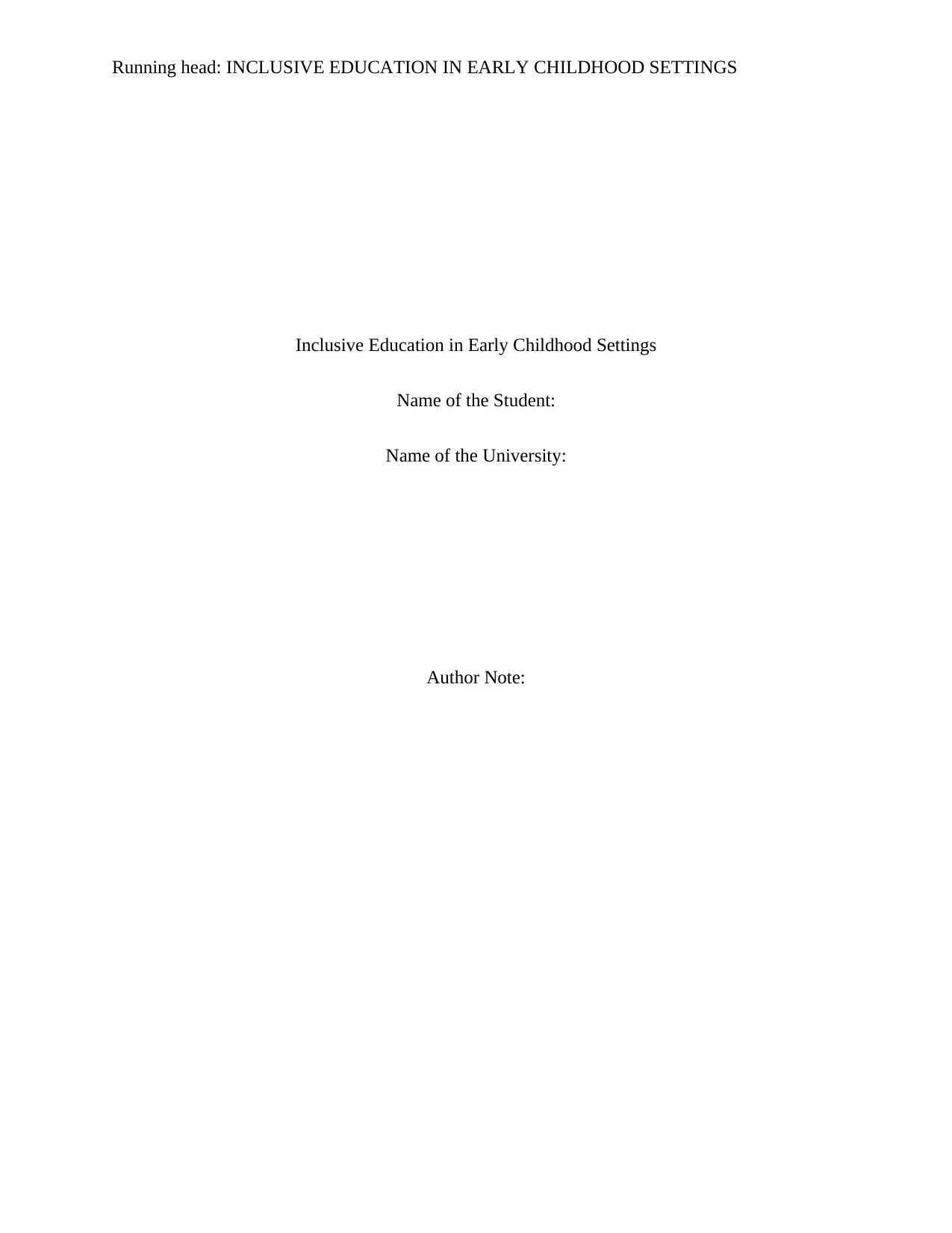
Running head: INCLUSIVE EDUCATION IN EARLY CHILDHOOD SETTINGS
Inclusive Education in Early Childhood Settings
Name of the Student:
Name of the University:
Author Note:
Inclusive Education in Early Childhood Settings
Name of the Student:
Name of the University:
Author Note:
Secure Best Marks with AI Grader
Need help grading? Try our AI Grader for instant feedback on your assignments.
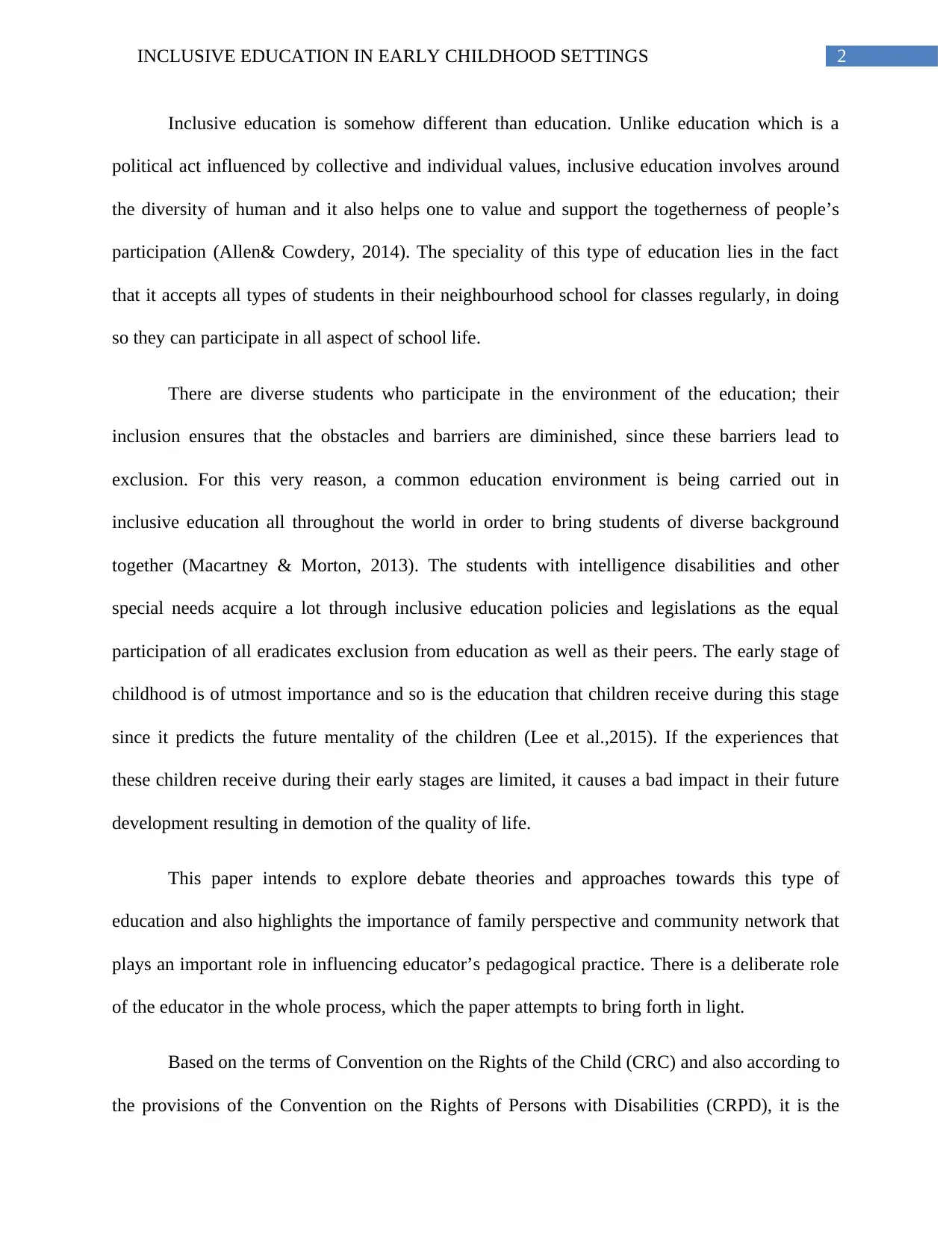
2INCLUSIVE EDUCATION IN EARLY CHILDHOOD SETTINGS
Inclusive education is somehow different than education. Unlike education which is a
political act influenced by collective and individual values, inclusive education involves around
the diversity of human and it also helps one to value and support the togetherness of people’s
participation (Allen& Cowdery, 2014). The speciality of this type of education lies in the fact
that it accepts all types of students in their neighbourhood school for classes regularly, in doing
so they can participate in all aspect of school life.
There are diverse students who participate in the environment of the education; their
inclusion ensures that the obstacles and barriers are diminished, since these barriers lead to
exclusion. For this very reason, a common education environment is being carried out in
inclusive education all throughout the world in order to bring students of diverse background
together (Macartney & Morton, 2013). The students with intelligence disabilities and other
special needs acquire a lot through inclusive education policies and legislations as the equal
participation of all eradicates exclusion from education as well as their peers. The early stage of
childhood is of utmost importance and so is the education that children receive during this stage
since it predicts the future mentality of the children (Lee et al.,2015). If the experiences that
these children receive during their early stages are limited, it causes a bad impact in their future
development resulting in demotion of the quality of life.
This paper intends to explore debate theories and approaches towards this type of
education and also highlights the importance of family perspective and community network that
plays an important role in influencing educator’s pedagogical practice. There is a deliberate role
of the educator in the whole process, which the paper attempts to bring forth in light.
Based on the terms of Convention on the Rights of the Child (CRC) and also according to
the provisions of the Convention on the Rights of Persons with Disabilities (CRPD), it is the
Inclusive education is somehow different than education. Unlike education which is a
political act influenced by collective and individual values, inclusive education involves around
the diversity of human and it also helps one to value and support the togetherness of people’s
participation (Allen& Cowdery, 2014). The speciality of this type of education lies in the fact
that it accepts all types of students in their neighbourhood school for classes regularly, in doing
so they can participate in all aspect of school life.
There are diverse students who participate in the environment of the education; their
inclusion ensures that the obstacles and barriers are diminished, since these barriers lead to
exclusion. For this very reason, a common education environment is being carried out in
inclusive education all throughout the world in order to bring students of diverse background
together (Macartney & Morton, 2013). The students with intelligence disabilities and other
special needs acquire a lot through inclusive education policies and legislations as the equal
participation of all eradicates exclusion from education as well as their peers. The early stage of
childhood is of utmost importance and so is the education that children receive during this stage
since it predicts the future mentality of the children (Lee et al.,2015). If the experiences that
these children receive during their early stages are limited, it causes a bad impact in their future
development resulting in demotion of the quality of life.
This paper intends to explore debate theories and approaches towards this type of
education and also highlights the importance of family perspective and community network that
plays an important role in influencing educator’s pedagogical practice. There is a deliberate role
of the educator in the whole process, which the paper attempts to bring forth in light.
Based on the terms of Convention on the Rights of the Child (CRC) and also according to
the provisions of the Convention on the Rights of Persons with Disabilities (CRPD), it is the
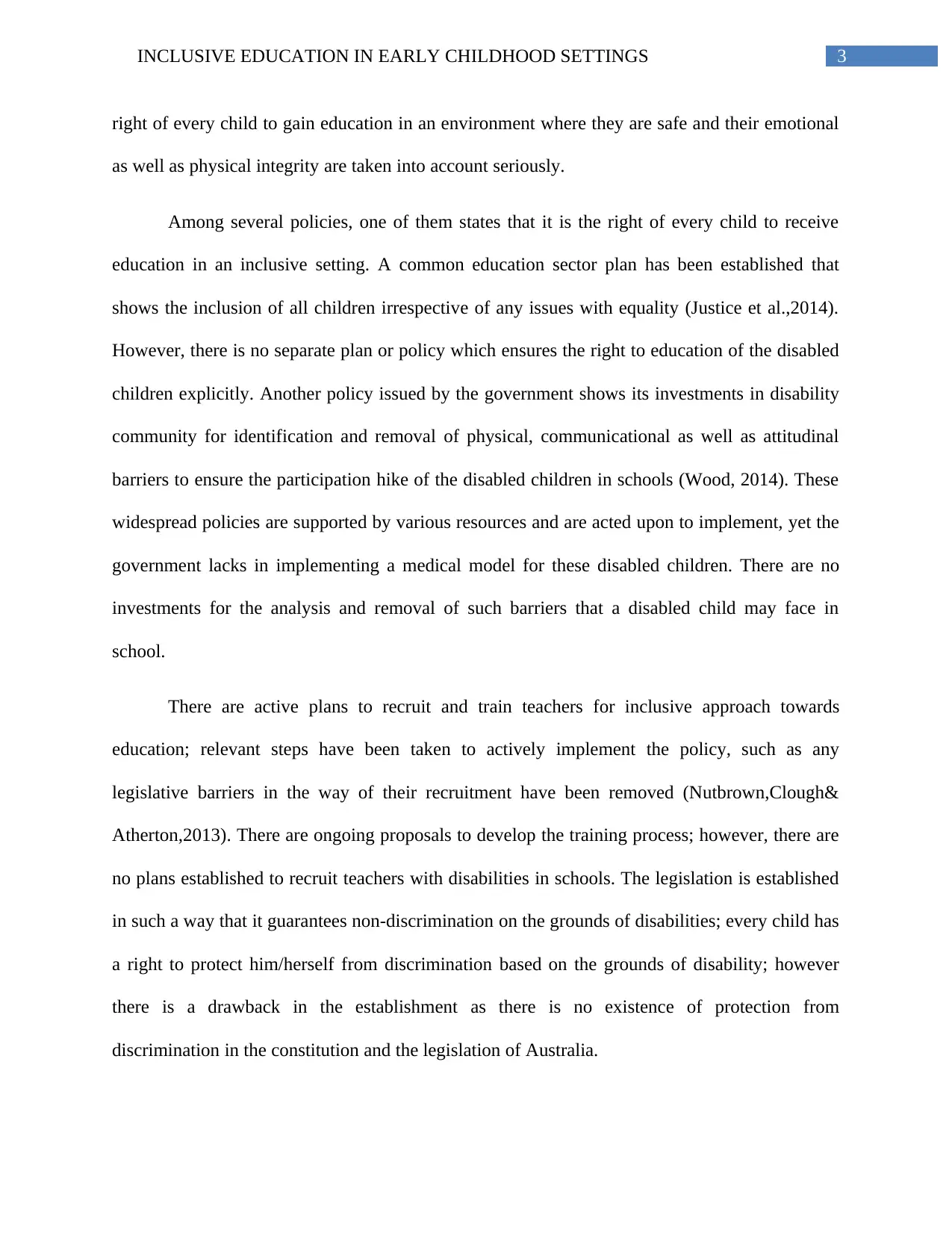
3INCLUSIVE EDUCATION IN EARLY CHILDHOOD SETTINGS
right of every child to gain education in an environment where they are safe and their emotional
as well as physical integrity are taken into account seriously.
Among several policies, one of them states that it is the right of every child to receive
education in an inclusive setting. A common education sector plan has been established that
shows the inclusion of all children irrespective of any issues with equality (Justice et al.,2014).
However, there is no separate plan or policy which ensures the right to education of the disabled
children explicitly. Another policy issued by the government shows its investments in disability
community for identification and removal of physical, communicational as well as attitudinal
barriers to ensure the participation hike of the disabled children in schools (Wood, 2014). These
widespread policies are supported by various resources and are acted upon to implement, yet the
government lacks in implementing a medical model for these disabled children. There are no
investments for the analysis and removal of such barriers that a disabled child may face in
school.
There are active plans to recruit and train teachers for inclusive approach towards
education; relevant steps have been taken to actively implement the policy, such as any
legislative barriers in the way of their recruitment have been removed (Nutbrown,Clough&
Atherton,2013). There are ongoing proposals to develop the training process; however, there are
no plans established to recruit teachers with disabilities in schools. The legislation is established
in such a way that it guarantees non-discrimination on the grounds of disabilities; every child has
a right to protect him/herself from discrimination based on the grounds of disability; however
there is a drawback in the establishment as there is no existence of protection from
discrimination in the constitution and the legislation of Australia.
right of every child to gain education in an environment where they are safe and their emotional
as well as physical integrity are taken into account seriously.
Among several policies, one of them states that it is the right of every child to receive
education in an inclusive setting. A common education sector plan has been established that
shows the inclusion of all children irrespective of any issues with equality (Justice et al.,2014).
However, there is no separate plan or policy which ensures the right to education of the disabled
children explicitly. Another policy issued by the government shows its investments in disability
community for identification and removal of physical, communicational as well as attitudinal
barriers to ensure the participation hike of the disabled children in schools (Wood, 2014). These
widespread policies are supported by various resources and are acted upon to implement, yet the
government lacks in implementing a medical model for these disabled children. There are no
investments for the analysis and removal of such barriers that a disabled child may face in
school.
There are active plans to recruit and train teachers for inclusive approach towards
education; relevant steps have been taken to actively implement the policy, such as any
legislative barriers in the way of their recruitment have been removed (Nutbrown,Clough&
Atherton,2013). There are ongoing proposals to develop the training process; however, there are
no plans established to recruit teachers with disabilities in schools. The legislation is established
in such a way that it guarantees non-discrimination on the grounds of disabilities; every child has
a right to protect him/herself from discrimination based on the grounds of disability; however
there is a drawback in the establishment as there is no existence of protection from
discrimination in the constitution and the legislation of Australia.
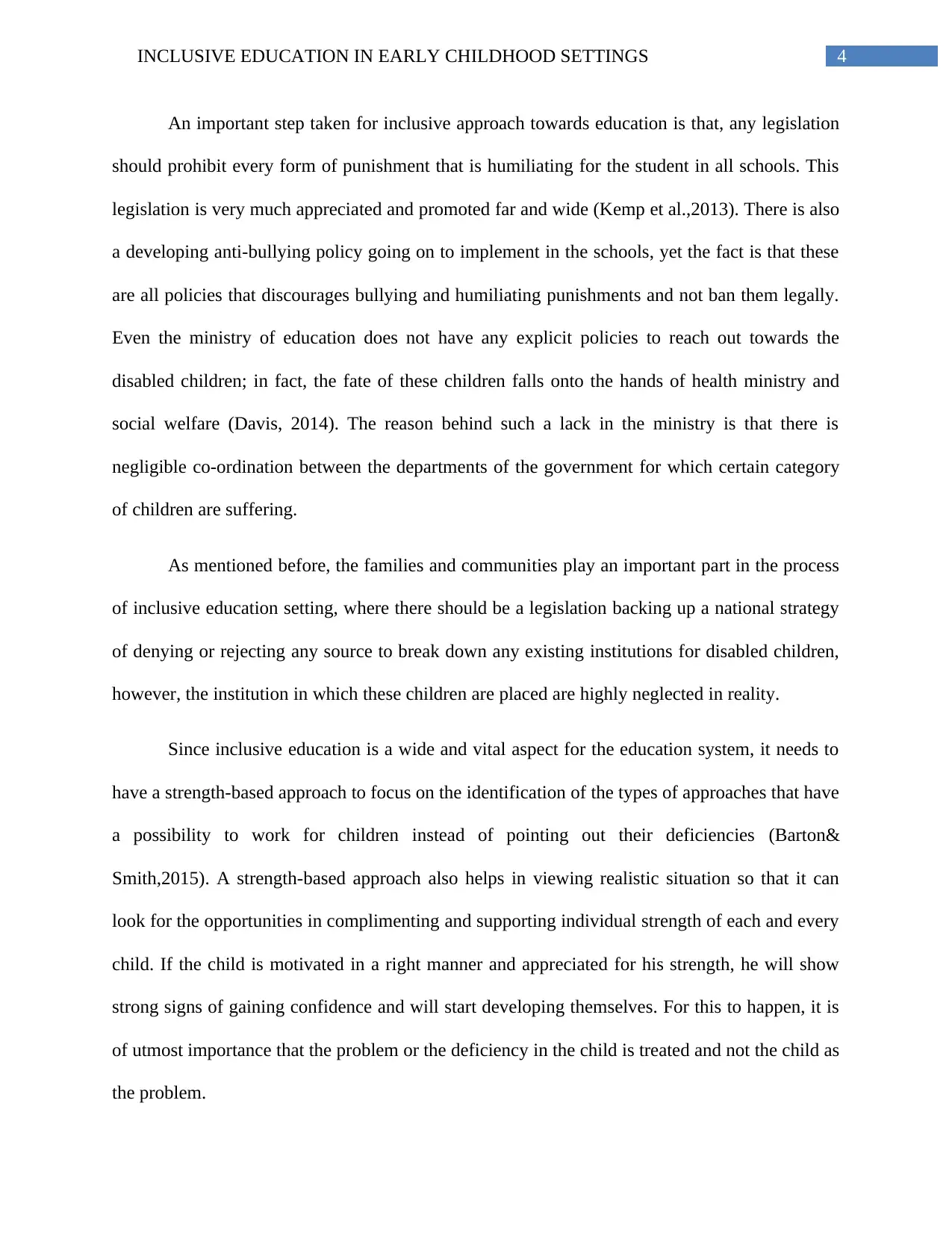
4INCLUSIVE EDUCATION IN EARLY CHILDHOOD SETTINGS
An important step taken for inclusive approach towards education is that, any legislation
should prohibit every form of punishment that is humiliating for the student in all schools. This
legislation is very much appreciated and promoted far and wide (Kemp et al.,2013). There is also
a developing anti-bullying policy going on to implement in the schools, yet the fact is that these
are all policies that discourages bullying and humiliating punishments and not ban them legally.
Even the ministry of education does not have any explicit policies to reach out towards the
disabled children; in fact, the fate of these children falls onto the hands of health ministry and
social welfare (Davis, 2014). The reason behind such a lack in the ministry is that there is
negligible co-ordination between the departments of the government for which certain category
of children are suffering.
As mentioned before, the families and communities play an important part in the process
of inclusive education setting, where there should be a legislation backing up a national strategy
of denying or rejecting any source to break down any existing institutions for disabled children,
however, the institution in which these children are placed are highly neglected in reality.
Since inclusive education is a wide and vital aspect for the education system, it needs to
have a strength-based approach to focus on the identification of the types of approaches that have
a possibility to work for children instead of pointing out their deficiencies (Barton&
Smith,2015). A strength-based approach also helps in viewing realistic situation so that it can
look for the opportunities in complimenting and supporting individual strength of each and every
child. If the child is motivated in a right manner and appreciated for his strength, he will show
strong signs of gaining confidence and will start developing themselves. For this to happen, it is
of utmost importance that the problem or the deficiency in the child is treated and not the child as
the problem.
An important step taken for inclusive approach towards education is that, any legislation
should prohibit every form of punishment that is humiliating for the student in all schools. This
legislation is very much appreciated and promoted far and wide (Kemp et al.,2013). There is also
a developing anti-bullying policy going on to implement in the schools, yet the fact is that these
are all policies that discourages bullying and humiliating punishments and not ban them legally.
Even the ministry of education does not have any explicit policies to reach out towards the
disabled children; in fact, the fate of these children falls onto the hands of health ministry and
social welfare (Davis, 2014). The reason behind such a lack in the ministry is that there is
negligible co-ordination between the departments of the government for which certain category
of children are suffering.
As mentioned before, the families and communities play an important part in the process
of inclusive education setting, where there should be a legislation backing up a national strategy
of denying or rejecting any source to break down any existing institutions for disabled children,
however, the institution in which these children are placed are highly neglected in reality.
Since inclusive education is a wide and vital aspect for the education system, it needs to
have a strength-based approach to focus on the identification of the types of approaches that have
a possibility to work for children instead of pointing out their deficiencies (Barton&
Smith,2015). A strength-based approach also helps in viewing realistic situation so that it can
look for the opportunities in complimenting and supporting individual strength of each and every
child. If the child is motivated in a right manner and appreciated for his strength, he will show
strong signs of gaining confidence and will start developing themselves. For this to happen, it is
of utmost importance that the problem or the deficiency in the child is treated and not the child as
the problem.
Secure Best Marks with AI Grader
Need help grading? Try our AI Grader for instant feedback on your assignments.
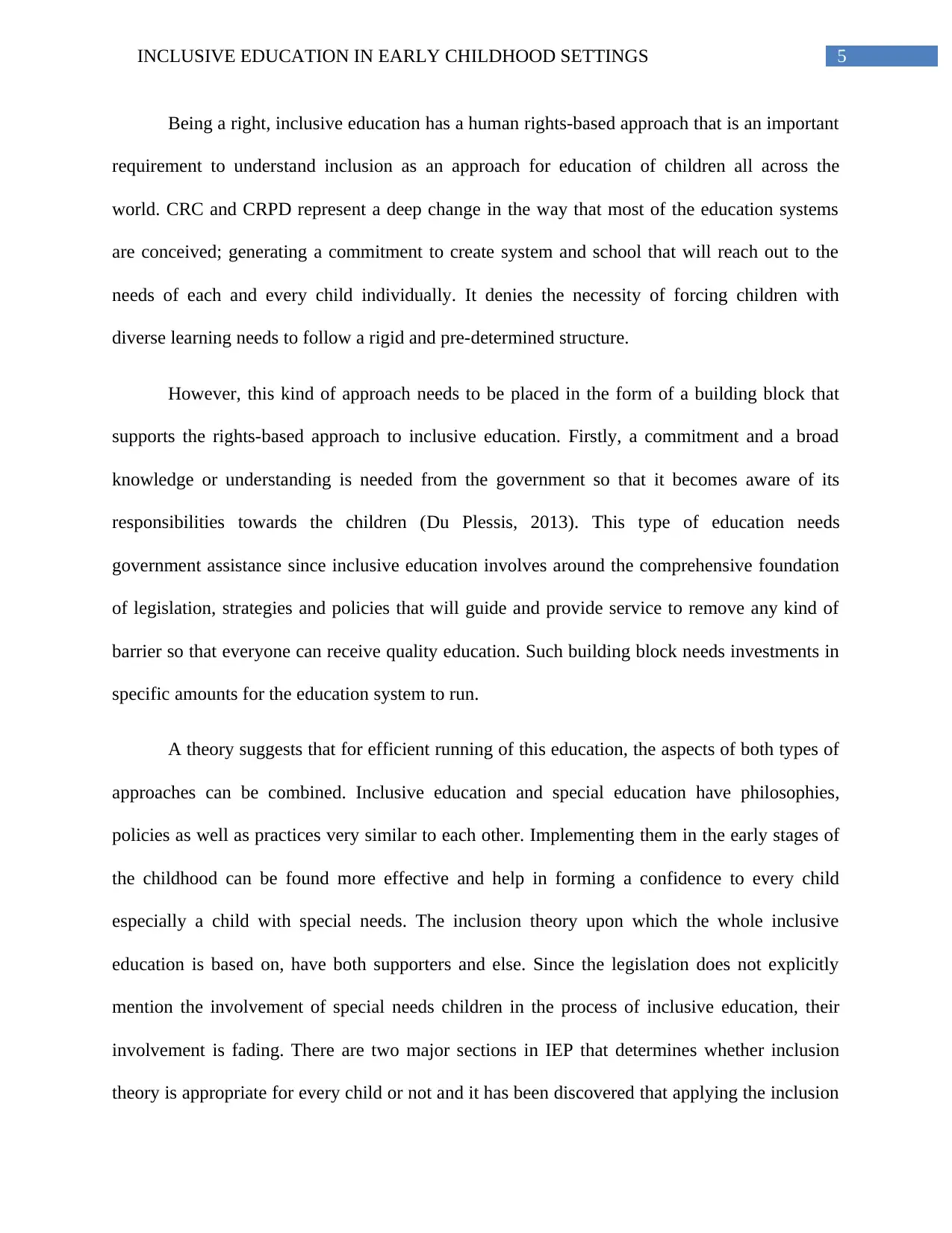
5INCLUSIVE EDUCATION IN EARLY CHILDHOOD SETTINGS
Being a right, inclusive education has a human rights-based approach that is an important
requirement to understand inclusion as an approach for education of children all across the
world. CRC and CRPD represent a deep change in the way that most of the education systems
are conceived; generating a commitment to create system and school that will reach out to the
needs of each and every child individually. It denies the necessity of forcing children with
diverse learning needs to follow a rigid and pre-determined structure.
However, this kind of approach needs to be placed in the form of a building block that
supports the rights-based approach to inclusive education. Firstly, a commitment and a broad
knowledge or understanding is needed from the government so that it becomes aware of its
responsibilities towards the children (Du Plessis, 2013). This type of education needs
government assistance since inclusive education involves around the comprehensive foundation
of legislation, strategies and policies that will guide and provide service to remove any kind of
barrier so that everyone can receive quality education. Such building block needs investments in
specific amounts for the education system to run.
A theory suggests that for efficient running of this education, the aspects of both types of
approaches can be combined. Inclusive education and special education have philosophies,
policies as well as practices very similar to each other. Implementing them in the early stages of
the childhood can be found more effective and help in forming a confidence to every child
especially a child with special needs. The inclusion theory upon which the whole inclusive
education is based on, have both supporters and else. Since the legislation does not explicitly
mention the involvement of special needs children in the process of inclusive education, their
involvement is fading. There are two major sections in IEP that determines whether inclusion
theory is appropriate for every child or not and it has been discovered that applying the inclusion
Being a right, inclusive education has a human rights-based approach that is an important
requirement to understand inclusion as an approach for education of children all across the
world. CRC and CRPD represent a deep change in the way that most of the education systems
are conceived; generating a commitment to create system and school that will reach out to the
needs of each and every child individually. It denies the necessity of forcing children with
diverse learning needs to follow a rigid and pre-determined structure.
However, this kind of approach needs to be placed in the form of a building block that
supports the rights-based approach to inclusive education. Firstly, a commitment and a broad
knowledge or understanding is needed from the government so that it becomes aware of its
responsibilities towards the children (Du Plessis, 2013). This type of education needs
government assistance since inclusive education involves around the comprehensive foundation
of legislation, strategies and policies that will guide and provide service to remove any kind of
barrier so that everyone can receive quality education. Such building block needs investments in
specific amounts for the education system to run.
A theory suggests that for efficient running of this education, the aspects of both types of
approaches can be combined. Inclusive education and special education have philosophies,
policies as well as practices very similar to each other. Implementing them in the early stages of
the childhood can be found more effective and help in forming a confidence to every child
especially a child with special needs. The inclusion theory upon which the whole inclusive
education is based on, have both supporters and else. Since the legislation does not explicitly
mention the involvement of special needs children in the process of inclusive education, their
involvement is fading. There are two major sections in IEP that determines whether inclusion
theory is appropriate for every child or not and it has been discovered that applying the inclusion
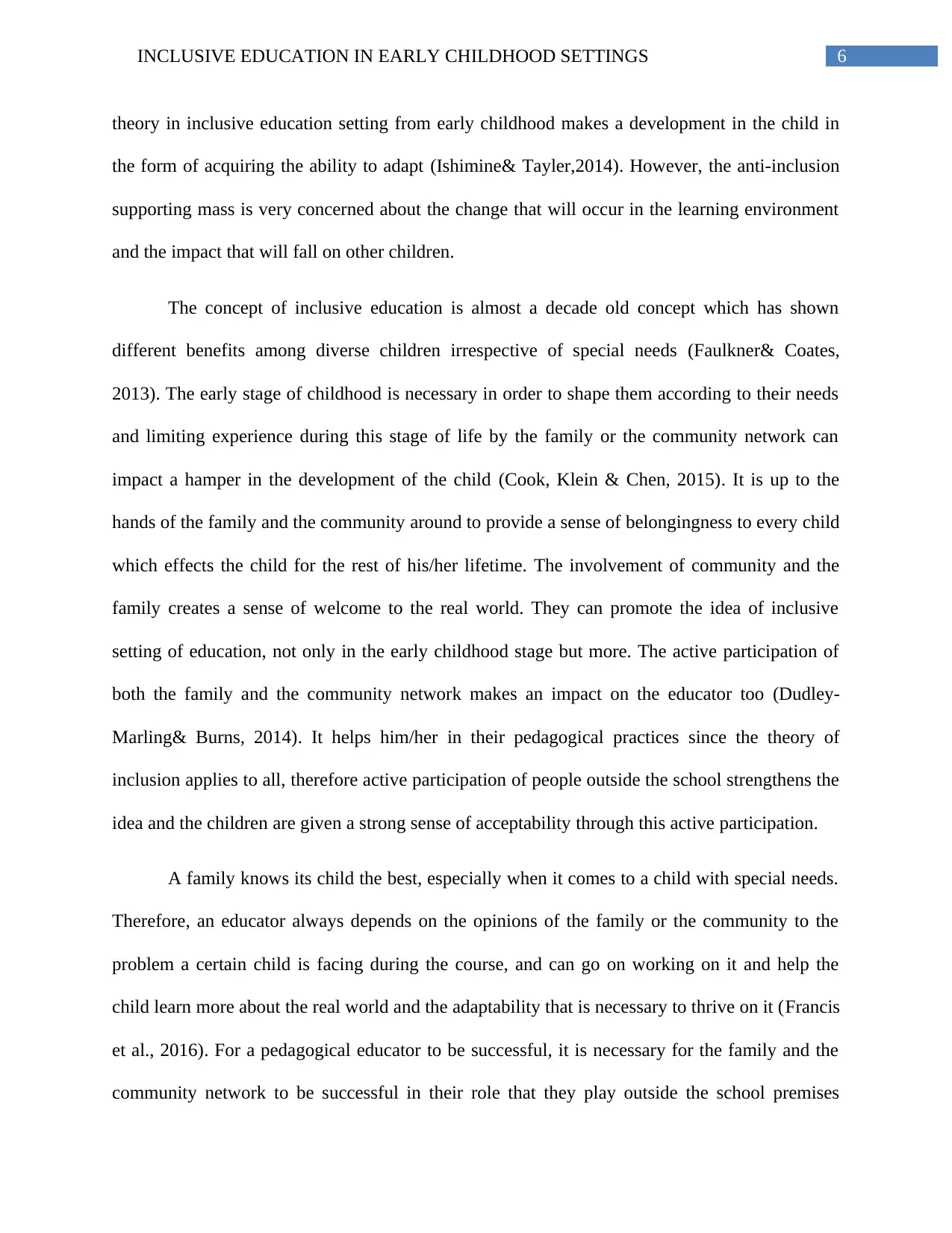
6INCLUSIVE EDUCATION IN EARLY CHILDHOOD SETTINGS
theory in inclusive education setting from early childhood makes a development in the child in
the form of acquiring the ability to adapt (Ishimine& Tayler,2014). However, the anti-inclusion
supporting mass is very concerned about the change that will occur in the learning environment
and the impact that will fall on other children.
The concept of inclusive education is almost a decade old concept which has shown
different benefits among diverse children irrespective of special needs (Faulkner& Coates,
2013). The early stage of childhood is necessary in order to shape them according to their needs
and limiting experience during this stage of life by the family or the community network can
impact a hamper in the development of the child (Cook, Klein & Chen, 2015). It is up to the
hands of the family and the community around to provide a sense of belongingness to every child
which effects the child for the rest of his/her lifetime. The involvement of community and the
family creates a sense of welcome to the real world. They can promote the idea of inclusive
setting of education, not only in the early childhood stage but more. The active participation of
both the family and the community network makes an impact on the educator too (Dudley-
Marling& Burns, 2014). It helps him/her in their pedagogical practices since the theory of
inclusion applies to all, therefore active participation of people outside the school strengthens the
idea and the children are given a strong sense of acceptability through this active participation.
A family knows its child the best, especially when it comes to a child with special needs.
Therefore, an educator always depends on the opinions of the family or the community to the
problem a certain child is facing during the course, and can go on working on it and help the
child learn more about the real world and the adaptability that is necessary to thrive on it (Francis
et al., 2016). For a pedagogical educator to be successful, it is necessary for the family and the
community network to be successful in their role that they play outside the school premises
theory in inclusive education setting from early childhood makes a development in the child in
the form of acquiring the ability to adapt (Ishimine& Tayler,2014). However, the anti-inclusion
supporting mass is very concerned about the change that will occur in the learning environment
and the impact that will fall on other children.
The concept of inclusive education is almost a decade old concept which has shown
different benefits among diverse children irrespective of special needs (Faulkner& Coates,
2013). The early stage of childhood is necessary in order to shape them according to their needs
and limiting experience during this stage of life by the family or the community network can
impact a hamper in the development of the child (Cook, Klein & Chen, 2015). It is up to the
hands of the family and the community around to provide a sense of belongingness to every child
which effects the child for the rest of his/her lifetime. The involvement of community and the
family creates a sense of welcome to the real world. They can promote the idea of inclusive
setting of education, not only in the early childhood stage but more. The active participation of
both the family and the community network makes an impact on the educator too (Dudley-
Marling& Burns, 2014). It helps him/her in their pedagogical practices since the theory of
inclusion applies to all, therefore active participation of people outside the school strengthens the
idea and the children are given a strong sense of acceptability through this active participation.
A family knows its child the best, especially when it comes to a child with special needs.
Therefore, an educator always depends on the opinions of the family or the community to the
problem a certain child is facing during the course, and can go on working on it and help the
child learn more about the real world and the adaptability that is necessary to thrive on it (Francis
et al., 2016). For a pedagogical educator to be successful, it is necessary for the family and the
community network to be successful in their role that they play outside the school premises
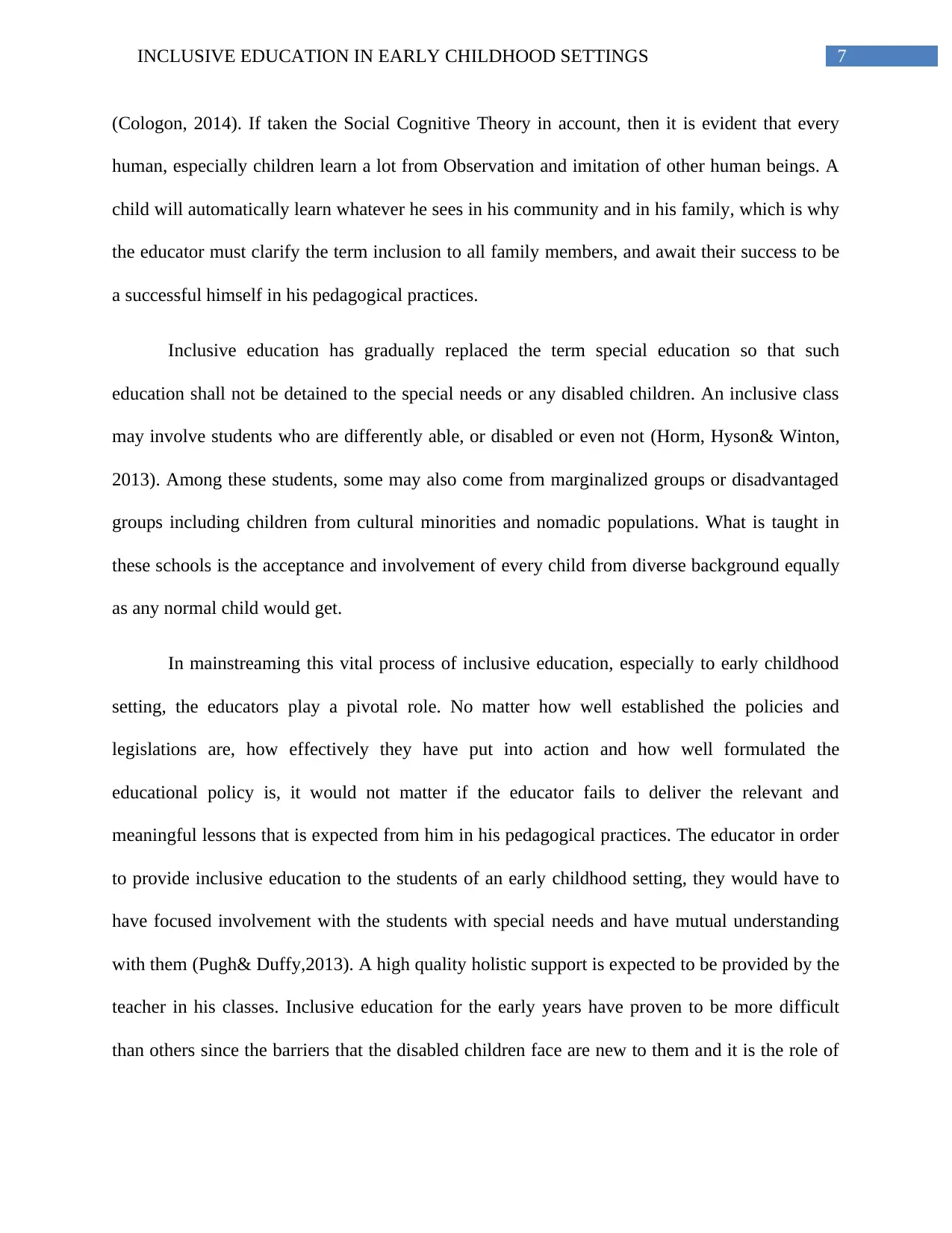
7INCLUSIVE EDUCATION IN EARLY CHILDHOOD SETTINGS
(Cologon, 2014). If taken the Social Cognitive Theory in account, then it is evident that every
human, especially children learn a lot from Observation and imitation of other human beings. A
child will automatically learn whatever he sees in his community and in his family, which is why
the educator must clarify the term inclusion to all family members, and await their success to be
a successful himself in his pedagogical practices.
Inclusive education has gradually replaced the term special education so that such
education shall not be detained to the special needs or any disabled children. An inclusive class
may involve students who are differently able, or disabled or even not (Horm, Hyson& Winton,
2013). Among these students, some may also come from marginalized groups or disadvantaged
groups including children from cultural minorities and nomadic populations. What is taught in
these schools is the acceptance and involvement of every child from diverse background equally
as any normal child would get.
In mainstreaming this vital process of inclusive education, especially to early childhood
setting, the educators play a pivotal role. No matter how well established the policies and
legislations are, how effectively they have put into action and how well formulated the
educational policy is, it would not matter if the educator fails to deliver the relevant and
meaningful lessons that is expected from him in his pedagogical practices. The educator in order
to provide inclusive education to the students of an early childhood setting, they would have to
have focused involvement with the students with special needs and have mutual understanding
with them (Pugh& Duffy,2013). A high quality holistic support is expected to be provided by the
teacher in his classes. Inclusive education for the early years have proven to be more difficult
than others since the barriers that the disabled children face are new to them and it is the role of
(Cologon, 2014). If taken the Social Cognitive Theory in account, then it is evident that every
human, especially children learn a lot from Observation and imitation of other human beings. A
child will automatically learn whatever he sees in his community and in his family, which is why
the educator must clarify the term inclusion to all family members, and await their success to be
a successful himself in his pedagogical practices.
Inclusive education has gradually replaced the term special education so that such
education shall not be detained to the special needs or any disabled children. An inclusive class
may involve students who are differently able, or disabled or even not (Horm, Hyson& Winton,
2013). Among these students, some may also come from marginalized groups or disadvantaged
groups including children from cultural minorities and nomadic populations. What is taught in
these schools is the acceptance and involvement of every child from diverse background equally
as any normal child would get.
In mainstreaming this vital process of inclusive education, especially to early childhood
setting, the educators play a pivotal role. No matter how well established the policies and
legislations are, how effectively they have put into action and how well formulated the
educational policy is, it would not matter if the educator fails to deliver the relevant and
meaningful lessons that is expected from him in his pedagogical practices. The educator in order
to provide inclusive education to the students of an early childhood setting, they would have to
have focused involvement with the students with special needs and have mutual understanding
with them (Pugh& Duffy,2013). A high quality holistic support is expected to be provided by the
teacher in his classes. Inclusive education for the early years have proven to be more difficult
than others since the barriers that the disabled children face are new to them and it is the role of
Paraphrase This Document
Need a fresh take? Get an instant paraphrase of this document with our AI Paraphraser
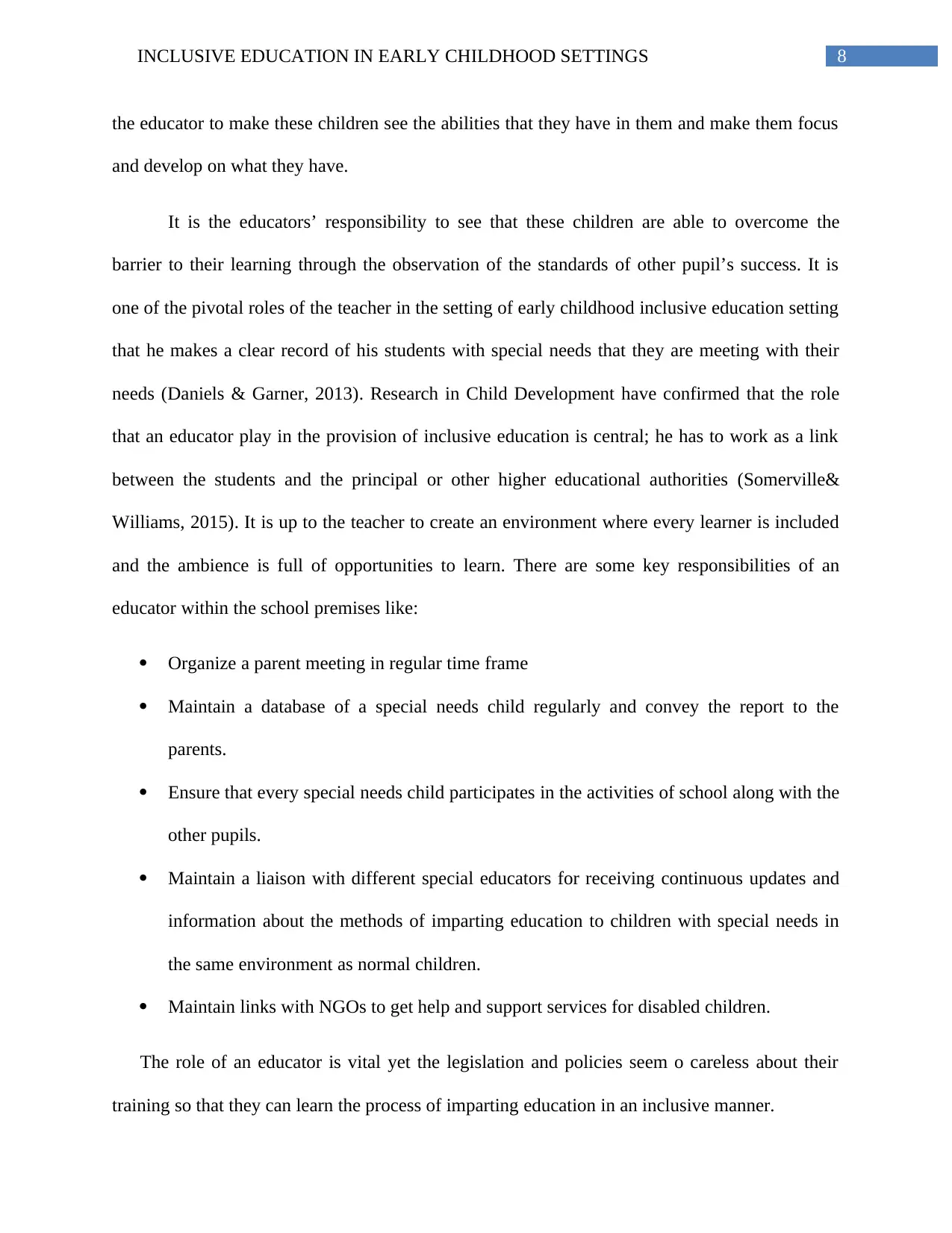
8INCLUSIVE EDUCATION IN EARLY CHILDHOOD SETTINGS
the educator to make these children see the abilities that they have in them and make them focus
and develop on what they have.
It is the educators’ responsibility to see that these children are able to overcome the
barrier to their learning through the observation of the standards of other pupil’s success. It is
one of the pivotal roles of the teacher in the setting of early childhood inclusive education setting
that he makes a clear record of his students with special needs that they are meeting with their
needs (Daniels & Garner, 2013). Research in Child Development have confirmed that the role
that an educator play in the provision of inclusive education is central; he has to work as a link
between the students and the principal or other higher educational authorities (Somerville&
Williams, 2015). It is up to the teacher to create an environment where every learner is included
and the ambience is full of opportunities to learn. There are some key responsibilities of an
educator within the school premises like:
Organize a parent meeting in regular time frame
Maintain a database of a special needs child regularly and convey the report to the
parents.
Ensure that every special needs child participates in the activities of school along with the
other pupils.
Maintain a liaison with different special educators for receiving continuous updates and
information about the methods of imparting education to children with special needs in
the same environment as normal children.
Maintain links with NGOs to get help and support services for disabled children.
The role of an educator is vital yet the legislation and policies seem o careless about their
training so that they can learn the process of imparting education in an inclusive manner.
the educator to make these children see the abilities that they have in them and make them focus
and develop on what they have.
It is the educators’ responsibility to see that these children are able to overcome the
barrier to their learning through the observation of the standards of other pupil’s success. It is
one of the pivotal roles of the teacher in the setting of early childhood inclusive education setting
that he makes a clear record of his students with special needs that they are meeting with their
needs (Daniels & Garner, 2013). Research in Child Development have confirmed that the role
that an educator play in the provision of inclusive education is central; he has to work as a link
between the students and the principal or other higher educational authorities (Somerville&
Williams, 2015). It is up to the teacher to create an environment where every learner is included
and the ambience is full of opportunities to learn. There are some key responsibilities of an
educator within the school premises like:
Organize a parent meeting in regular time frame
Maintain a database of a special needs child regularly and convey the report to the
parents.
Ensure that every special needs child participates in the activities of school along with the
other pupils.
Maintain a liaison with different special educators for receiving continuous updates and
information about the methods of imparting education to children with special needs in
the same environment as normal children.
Maintain links with NGOs to get help and support services for disabled children.
The role of an educator is vital yet the legislation and policies seem o careless about their
training so that they can learn the process of imparting education in an inclusive manner.
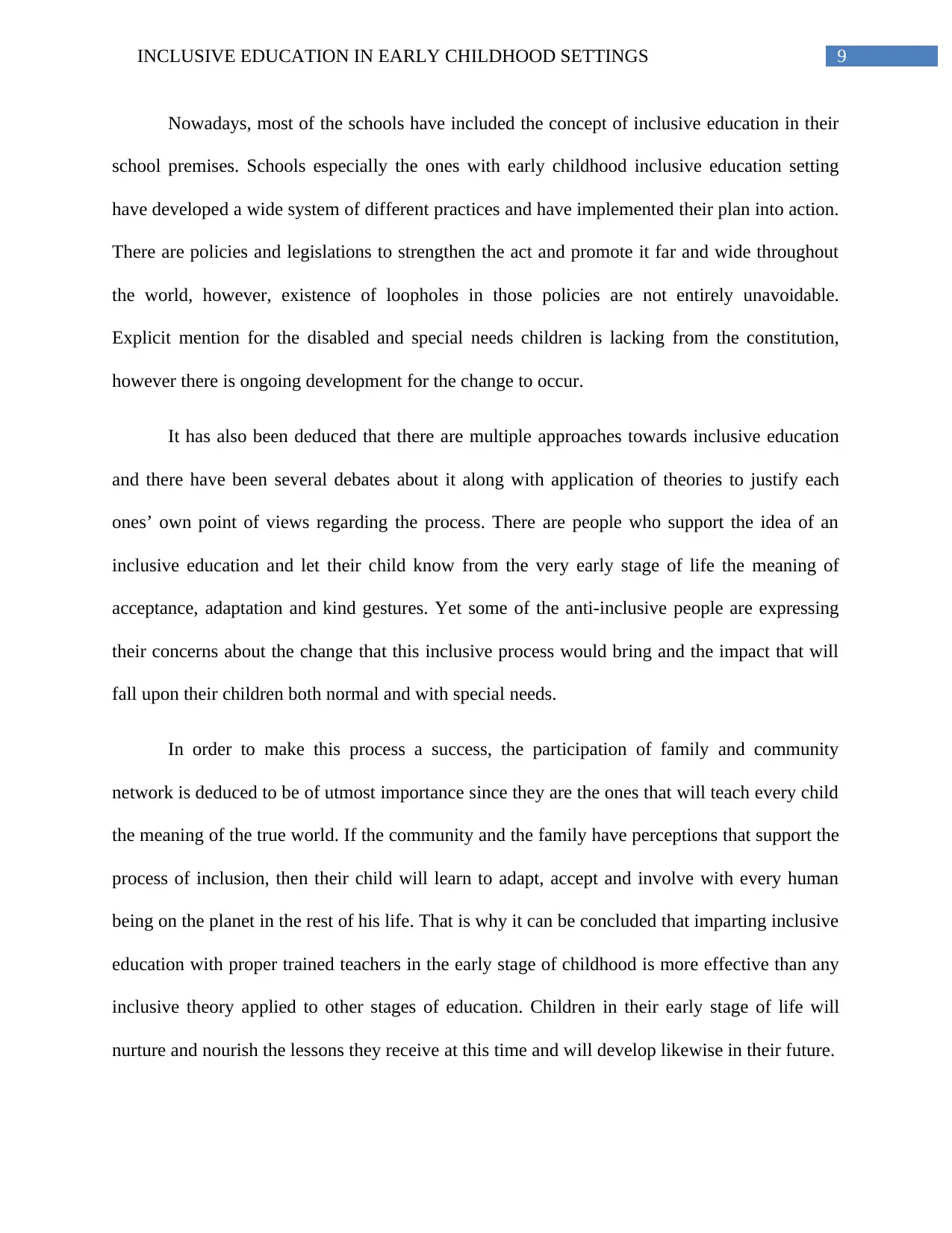
9INCLUSIVE EDUCATION IN EARLY CHILDHOOD SETTINGS
Nowadays, most of the schools have included the concept of inclusive education in their
school premises. Schools especially the ones with early childhood inclusive education setting
have developed a wide system of different practices and have implemented their plan into action.
There are policies and legislations to strengthen the act and promote it far and wide throughout
the world, however, existence of loopholes in those policies are not entirely unavoidable.
Explicit mention for the disabled and special needs children is lacking from the constitution,
however there is ongoing development for the change to occur.
It has also been deduced that there are multiple approaches towards inclusive education
and there have been several debates about it along with application of theories to justify each
ones’ own point of views regarding the process. There are people who support the idea of an
inclusive education and let their child know from the very early stage of life the meaning of
acceptance, adaptation and kind gestures. Yet some of the anti-inclusive people are expressing
their concerns about the change that this inclusive process would bring and the impact that will
fall upon their children both normal and with special needs.
In order to make this process a success, the participation of family and community
network is deduced to be of utmost importance since they are the ones that will teach every child
the meaning of the true world. If the community and the family have perceptions that support the
process of inclusion, then their child will learn to adapt, accept and involve with every human
being on the planet in the rest of his life. That is why it can be concluded that imparting inclusive
education with proper trained teachers in the early stage of childhood is more effective than any
inclusive theory applied to other stages of education. Children in their early stage of life will
nurture and nourish the lessons they receive at this time and will develop likewise in their future.
Nowadays, most of the schools have included the concept of inclusive education in their
school premises. Schools especially the ones with early childhood inclusive education setting
have developed a wide system of different practices and have implemented their plan into action.
There are policies and legislations to strengthen the act and promote it far and wide throughout
the world, however, existence of loopholes in those policies are not entirely unavoidable.
Explicit mention for the disabled and special needs children is lacking from the constitution,
however there is ongoing development for the change to occur.
It has also been deduced that there are multiple approaches towards inclusive education
and there have been several debates about it along with application of theories to justify each
ones’ own point of views regarding the process. There are people who support the idea of an
inclusive education and let their child know from the very early stage of life the meaning of
acceptance, adaptation and kind gestures. Yet some of the anti-inclusive people are expressing
their concerns about the change that this inclusive process would bring and the impact that will
fall upon their children both normal and with special needs.
In order to make this process a success, the participation of family and community
network is deduced to be of utmost importance since they are the ones that will teach every child
the meaning of the true world. If the community and the family have perceptions that support the
process of inclusion, then their child will learn to adapt, accept and involve with every human
being on the planet in the rest of his life. That is why it can be concluded that imparting inclusive
education with proper trained teachers in the early stage of childhood is more effective than any
inclusive theory applied to other stages of education. Children in their early stage of life will
nurture and nourish the lessons they receive at this time and will develop likewise in their future.
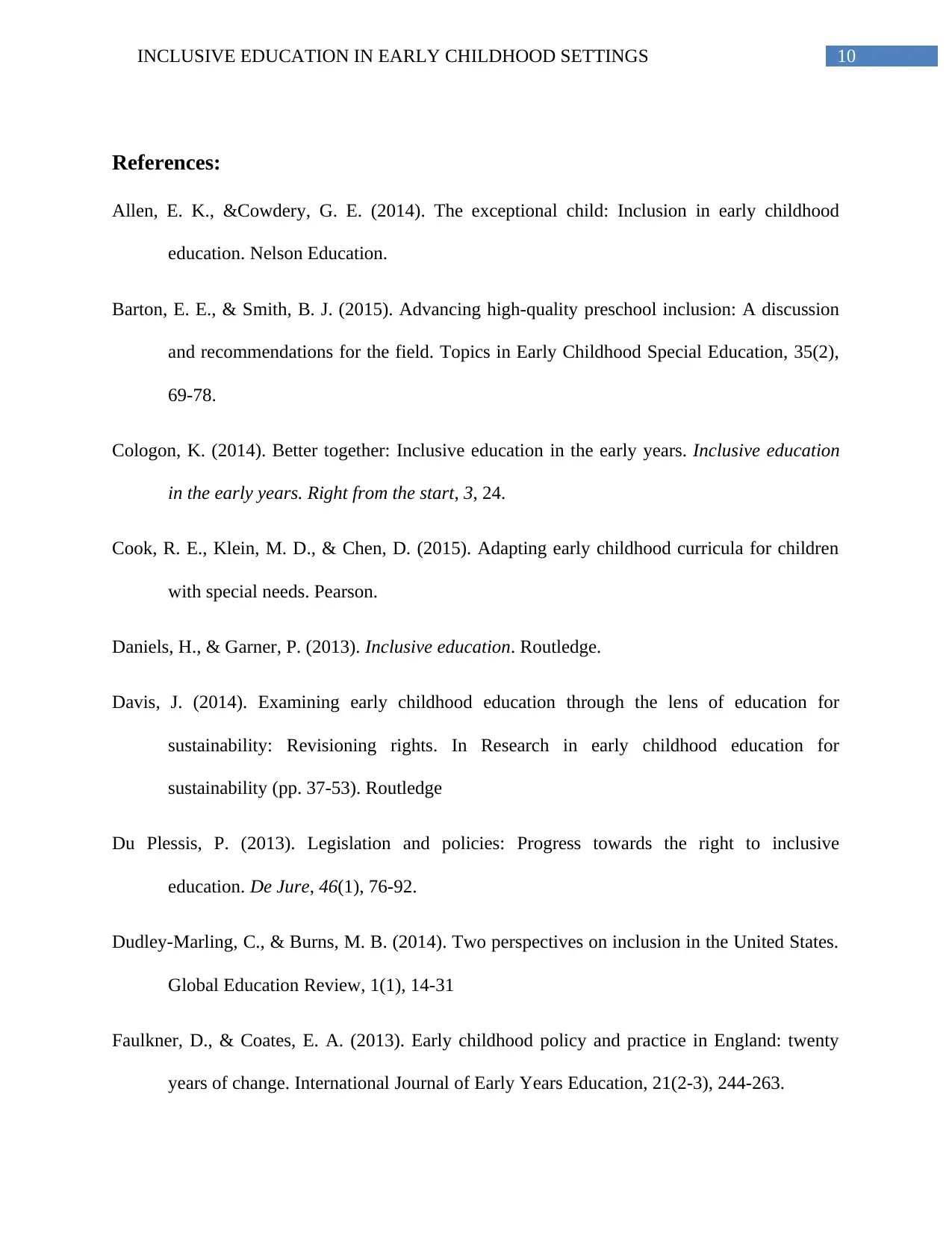
10INCLUSIVE EDUCATION IN EARLY CHILDHOOD SETTINGS
References:
Allen, E. K., &Cowdery, G. E. (2014). The exceptional child: Inclusion in early childhood
education. Nelson Education.
Barton, E. E., & Smith, B. J. (2015). Advancing high-quality preschool inclusion: A discussion
and recommendations for the field. Topics in Early Childhood Special Education, 35(2),
69-78.
Cologon, K. (2014). Better together: Inclusive education in the early years. Inclusive education
in the early years. Right from the start, 3, 24.
Cook, R. E., Klein, M. D., & Chen, D. (2015). Adapting early childhood curricula for children
with special needs. Pearson.
Daniels, H., & Garner, P. (2013). Inclusive education. Routledge.
Davis, J. (2014). Examining early childhood education through the lens of education for
sustainability: Revisioning rights. In Research in early childhood education for
sustainability (pp. 37-53). Routledge
Du Plessis, P. (2013). Legislation and policies: Progress towards the right to inclusive
education. De Jure, 46(1), 76-92.
Dudley-Marling, C., & Burns, M. B. (2014). Two perspectives on inclusion in the United States.
Global Education Review, 1(1), 14-31
Faulkner, D., & Coates, E. A. (2013). Early childhood policy and practice in England: twenty
years of change. International Journal of Early Years Education, 21(2-3), 244-263.
References:
Allen, E. K., &Cowdery, G. E. (2014). The exceptional child: Inclusion in early childhood
education. Nelson Education.
Barton, E. E., & Smith, B. J. (2015). Advancing high-quality preschool inclusion: A discussion
and recommendations for the field. Topics in Early Childhood Special Education, 35(2),
69-78.
Cologon, K. (2014). Better together: Inclusive education in the early years. Inclusive education
in the early years. Right from the start, 3, 24.
Cook, R. E., Klein, M. D., & Chen, D. (2015). Adapting early childhood curricula for children
with special needs. Pearson.
Daniels, H., & Garner, P. (2013). Inclusive education. Routledge.
Davis, J. (2014). Examining early childhood education through the lens of education for
sustainability: Revisioning rights. In Research in early childhood education for
sustainability (pp. 37-53). Routledge
Du Plessis, P. (2013). Legislation and policies: Progress towards the right to inclusive
education. De Jure, 46(1), 76-92.
Dudley-Marling, C., & Burns, M. B. (2014). Two perspectives on inclusion in the United States.
Global Education Review, 1(1), 14-31
Faulkner, D., & Coates, E. A. (2013). Early childhood policy and practice in England: twenty
years of change. International Journal of Early Years Education, 21(2-3), 244-263.
Secure Best Marks with AI Grader
Need help grading? Try our AI Grader for instant feedback on your assignments.
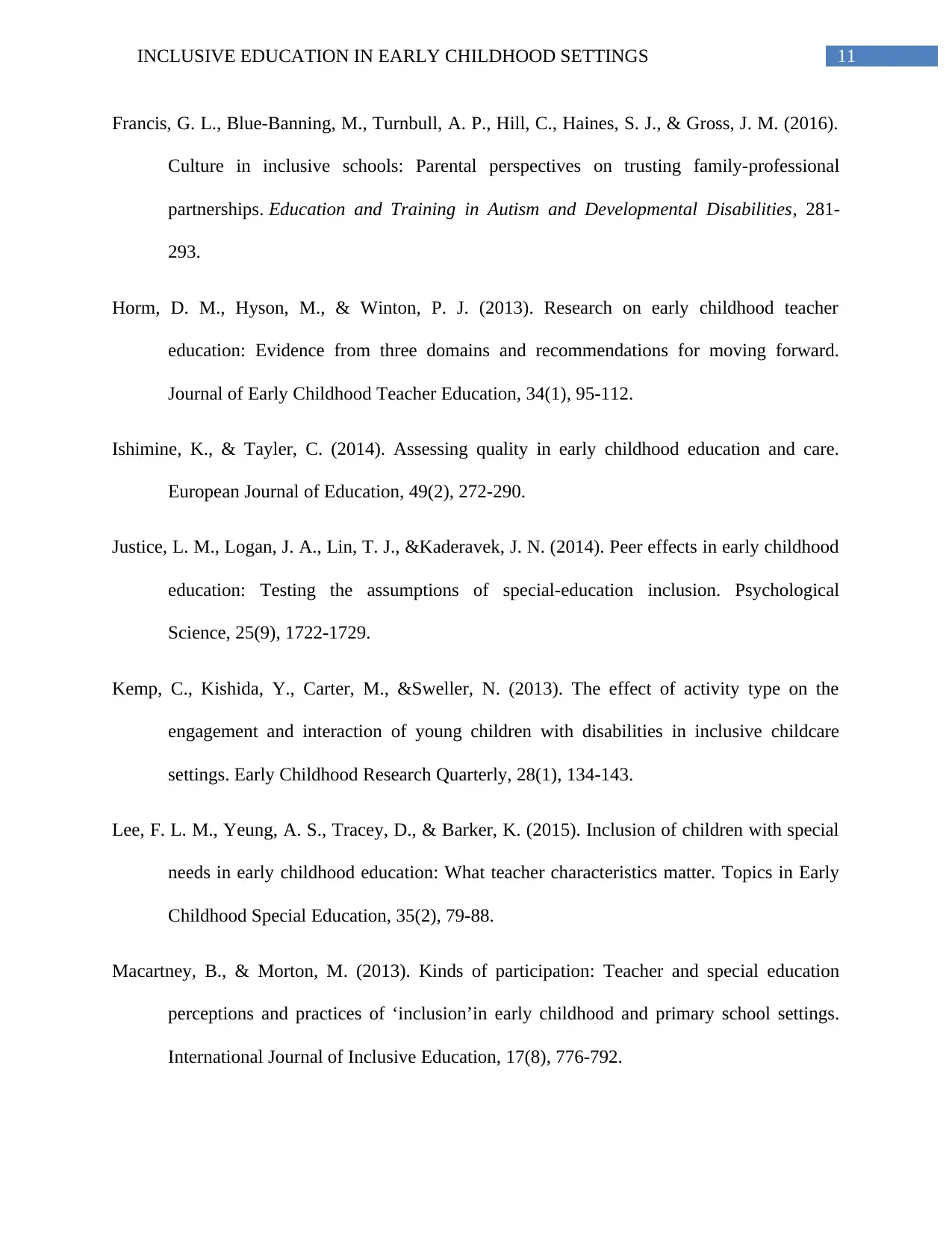
11INCLUSIVE EDUCATION IN EARLY CHILDHOOD SETTINGS
Francis, G. L., Blue-Banning, M., Turnbull, A. P., Hill, C., Haines, S. J., & Gross, J. M. (2016).
Culture in inclusive schools: Parental perspectives on trusting family-professional
partnerships. Education and Training in Autism and Developmental Disabilities, 281-
293.
Horm, D. M., Hyson, M., & Winton, P. J. (2013). Research on early childhood teacher
education: Evidence from three domains and recommendations for moving forward.
Journal of Early Childhood Teacher Education, 34(1), 95-112.
Ishimine, K., & Tayler, C. (2014). Assessing quality in early childhood education and care.
European Journal of Education, 49(2), 272-290.
Justice, L. M., Logan, J. A., Lin, T. J., &Kaderavek, J. N. (2014). Peer effects in early childhood
education: Testing the assumptions of special-education inclusion. Psychological
Science, 25(9), 1722-1729.
Kemp, C., Kishida, Y., Carter, M., &Sweller, N. (2013). The effect of activity type on the
engagement and interaction of young children with disabilities in inclusive childcare
settings. Early Childhood Research Quarterly, 28(1), 134-143.
Lee, F. L. M., Yeung, A. S., Tracey, D., & Barker, K. (2015). Inclusion of children with special
needs in early childhood education: What teacher characteristics matter. Topics in Early
Childhood Special Education, 35(2), 79-88.
Macartney, B., & Morton, M. (2013). Kinds of participation: Teacher and special education
perceptions and practices of ‘inclusion’in early childhood and primary school settings.
International Journal of Inclusive Education, 17(8), 776-792.
Francis, G. L., Blue-Banning, M., Turnbull, A. P., Hill, C., Haines, S. J., & Gross, J. M. (2016).
Culture in inclusive schools: Parental perspectives on trusting family-professional
partnerships. Education and Training in Autism and Developmental Disabilities, 281-
293.
Horm, D. M., Hyson, M., & Winton, P. J. (2013). Research on early childhood teacher
education: Evidence from three domains and recommendations for moving forward.
Journal of Early Childhood Teacher Education, 34(1), 95-112.
Ishimine, K., & Tayler, C. (2014). Assessing quality in early childhood education and care.
European Journal of Education, 49(2), 272-290.
Justice, L. M., Logan, J. A., Lin, T. J., &Kaderavek, J. N. (2014). Peer effects in early childhood
education: Testing the assumptions of special-education inclusion. Psychological
Science, 25(9), 1722-1729.
Kemp, C., Kishida, Y., Carter, M., &Sweller, N. (2013). The effect of activity type on the
engagement and interaction of young children with disabilities in inclusive childcare
settings. Early Childhood Research Quarterly, 28(1), 134-143.
Lee, F. L. M., Yeung, A. S., Tracey, D., & Barker, K. (2015). Inclusion of children with special
needs in early childhood education: What teacher characteristics matter. Topics in Early
Childhood Special Education, 35(2), 79-88.
Macartney, B., & Morton, M. (2013). Kinds of participation: Teacher and special education
perceptions and practices of ‘inclusion’in early childhood and primary school settings.
International Journal of Inclusive Education, 17(8), 776-792.
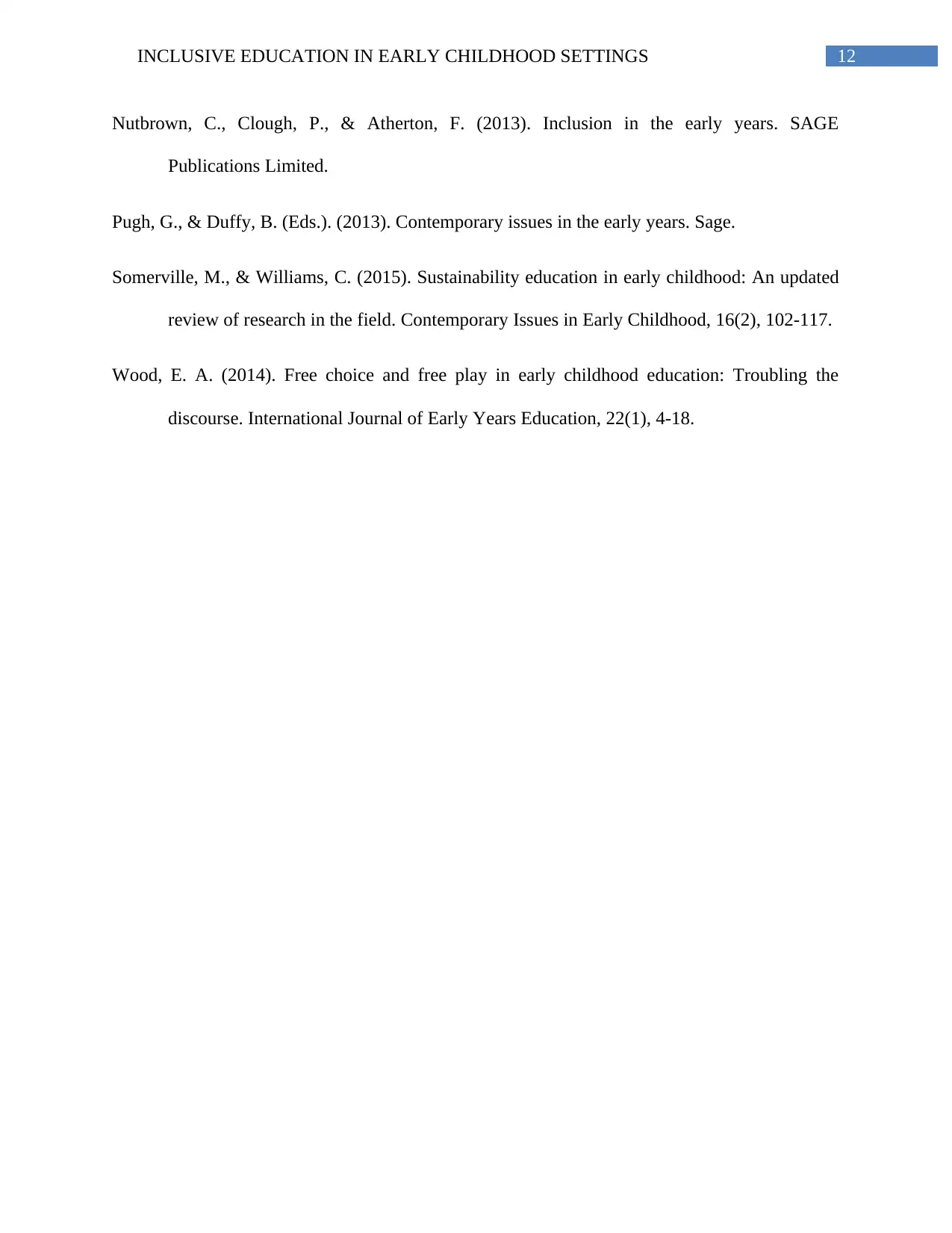
12INCLUSIVE EDUCATION IN EARLY CHILDHOOD SETTINGS
Nutbrown, C., Clough, P., & Atherton, F. (2013). Inclusion in the early years. SAGE
Publications Limited.
Pugh, G., & Duffy, B. (Eds.). (2013). Contemporary issues in the early years. Sage.
Somerville, M., & Williams, C. (2015). Sustainability education in early childhood: An updated
review of research in the field. Contemporary Issues in Early Childhood, 16(2), 102-117.
Wood, E. A. (2014). Free choice and free play in early childhood education: Troubling the
discourse. International Journal of Early Years Education, 22(1), 4-18.
Nutbrown, C., Clough, P., & Atherton, F. (2013). Inclusion in the early years. SAGE
Publications Limited.
Pugh, G., & Duffy, B. (Eds.). (2013). Contemporary issues in the early years. Sage.
Somerville, M., & Williams, C. (2015). Sustainability education in early childhood: An updated
review of research in the field. Contemporary Issues in Early Childhood, 16(2), 102-117.
Wood, E. A. (2014). Free choice and free play in early childhood education: Troubling the
discourse. International Journal of Early Years Education, 22(1), 4-18.
1 out of 12
Related Documents
Your All-in-One AI-Powered Toolkit for Academic Success.
+13062052269
info@desklib.com
Available 24*7 on WhatsApp / Email
![[object Object]](/_next/static/media/star-bottom.7253800d.svg)
Unlock your academic potential
© 2024 | Zucol Services PVT LTD | All rights reserved.





